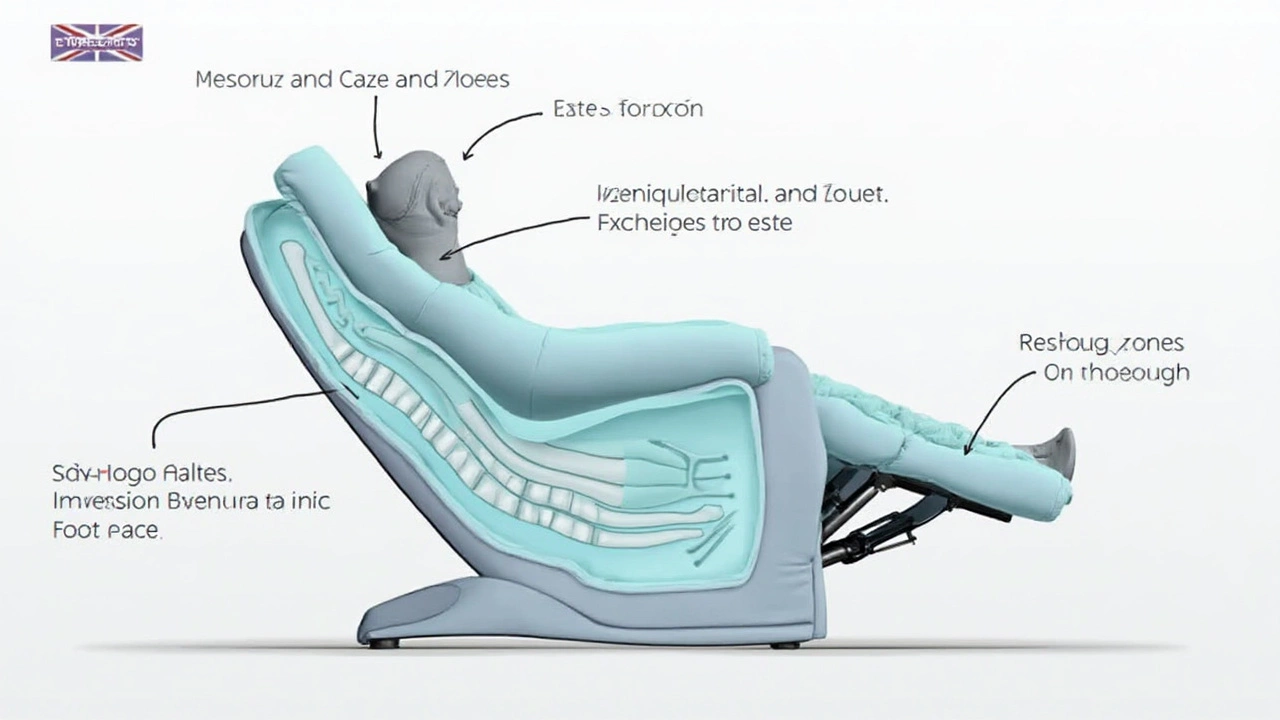 8
May,2025
8
May,2025
Check out any living room and you'll spot at least one recliner taking up prime real estate. Here’s the thing—most folks never think about where their feet should actually land. Should they dangle off the edge, or rest fully on the footrest? It's not just a matter of looks; it really changes how your whole body feels after a long movie night or a lazy Sunday nap.
When your feet hang too far off, you might notice your ankles or calves feeling sore. But if your legs are bunched up, your knees get cramped, which can be just as annoying. It all comes down to how well your recliner fits your body. The right setup keeps your feet relaxed and your legs supported, helping your back and neck stay happy, too.
- Why Foot Placement Matters in a Recliner
- How Much Overhang Is Too Much?
- What Happens to Comfort and Posture
- Tips for the Perfect Recliner Fit
Why Foot Placement Matters in a Recliner
Ever notice how a bad footrest setup on a recliner can leave your feet speckled with red marks or even make them go numb? Where your feet end up plays a bigger role than you might think. When you sit back in a recliner, your heels, calves, and lower back all rely on proper leg support to keep everything aligned. Without the right support, your body pays for it with aches and poor posture.
This isn’t just a guess—orthopedic experts agree that letting your feet dangle too much strains your ankles and knees. On the flip side, if your heels dig into the hard edge of the footrest, it can cut off circulation and leave you shifting around, trying to get comfy. Either scenario messes with your ability to truly relax, which is really the whole point of a recliner in the first place.
Here’s a quick look at the basics of foot placement and what each one means for your comfort:
- Feet fully supported: Best for keeping pressure off your lower legs and keeping your back straight.
- Feet hanging off just a bit: Usually fine if the overhang is a couple of inches and not pulling at your ankles.
- Feet dangling a lot: Most likely to cause soreness or tingling, especially on longer sessions.
Most recliner brands actually list maximum height and leg length recommendations because they know a good fit matters. Studies on recliner ergonomics have found people with properly supported feet report less soreness and fewer leg cramps—hard to argue with stats like that when you’re after real comfort. At the end of the day, recliner fit isn’t just for show; if your feet are left hanging, your whole body feels it.
How Much Overhang Is Too Much?
If your heels are suspended in the air while relaxing in a recliner, it’s time to rethink the fit. Ideally, your feet should rest flat on the footrest, or just barely hang off by an inch or two—not more. Experts from the American Chiropractic Association point out that too much overhang can stress your ankle joints and create unnecessary pressure on your calves.
Dr. Steven Knauf, a chiropractic physician, says, “When your heels don’t have support and end up dangling, you put extra load on your lower legs and back. Even twenty minutes like this can start to create discomfort or tingling in your feet.”
A good rule of thumb? If more than a quarter of your foot is off the footrest, your chair is probably too short. People under six feet tall can often get away with a smaller footrest, but anyone taller really needs that extra length. Here’s how that overhang breaks down:
| Foot Overhang (inches) | Comfort Level |
|---|---|
| 0-1.5" | Ideal—no pressure points |
| 2-3" | Acceptable for short periods |
| 4" and up | Expect leg numbness and sore ankles |
Another quick test: if your feet are sliding down or your calves feel pinched when you extend the recliner, you’ve got too much overhang. Also, look for signs like red marks on your legs or pins and needles after you stand up. These are classic signals that your recliner isn’t giving your legs what they need.
The fix is simpler than it sounds. Try adjusting the recline angle or switch chairs if you just can’t get a good fit. Some folks use a firm pillow under their feet for temporary relief, but the best answer is matching your body length to the right recliner size. You deserve a chair that works for you, not against you.

What Happens to Comfort and Posture
If your feet hang off a recliner too much, you’ll probably feel it before you notice it. At first, your toes might get tingly, or your ankles might start aching, especially if they’re dangling with no support. Over time, this pressure can make your lower legs and feet go numb, or even cramp up. That’s because blood flow slows down when your legs aren’t supported well, and your muscles have to work harder just to keep your feet propped up.
Low back pain can sneak up too, because your pelvis tilts weirdly if your legs aren’t level. That puts strain on your spine and messes with your posture. According to a 2022 study published in the journal "Ergonomics," sitting with your legs supported reduces the risk of musculoskeletal fatigue by over 40% compared to sitting with your feet dangling.
Here’s the rundown of what happens when your recliner isn’t the right size, or you’re using it wrong:
- Poor foot support strains ankles and calves
- Lack of leg support twists your hips or low back
- Numb feet due to reduced circulation
- Neck and upper back discomfort if you slouch to compensate
The best-case scenario is to have your heels resting comfortably at the edge of the footrest. If your knees are higher than your hips or your feet dangle, your recliner isn’t giving you what you need. The sweet spot is when your legs feel weightless and you don’t have to flex your ankles or knees to stay in place.
Here’s a quick reference so you can size up your comfort:
| Foot Position | Feeling After 30 Minutes |
|---|---|
| Fully Supported | Relaxed, no soreness |
| Partial Overhang | Mild ankle or calf tension |
| Dangling Completely | Numbness, cramping, possible back pain |
If you catch yourself fidgeting, shifting around, or crossing your ankles to get comfy, your chair might not be set up right. Paying attention to these small things can save you from big aches later on.
Tips for the Perfect Recliner Fit
Getting the most comfy setup out of your recliner is all about making sure your body lines up with the design. Most folks don't even realize their chair can be adjusted or that picking the right size can prevent aches and weird pressure points. Here are some practical tips you can put to use right now.
- Check the Length: When sitting back, your heels should either just touch or barely float above the end of the footrest. If your feet dangle far off, the recliner may be too short for you. If your calves press hard against the edge, it’s probably too long.
- Adjust the Backrest: Try multiple angles. Sometimes, leaning back a little more lets your legs stretch out so your feet feel more supported.
- Add Support if Needed: If your chair’s footrest is too short, toss a small pillow or cushion under your ankles. This quick fix can reduce strain and lets you enjoy your chair without splurging on a new one.
- Consider Foot Size: Some brands make recliners in different lengths or even offer “tall” and “petite” models. If you’re shopping for a new chair, bring your shoe size into the mix and test sitting with your shoes off to get the most realistic feel.
- Check for Adjustable Features: Higher-end recliners often let you move the footrest or extend it, which helps people with longer legs get that perfect fit.
Here’s a snack-sized chart showing standard footrest lengths for home recliners and why size matters:
| Height Range | Recommended Footrest Length |
|---|---|
| Under 5'6" | 16-18 inches |
| 5'7" - 6'0" | 18-20 inches |
| Over 6'0" | 20+ inches |
Remember, if you’re sharing the chair with someone of a different height, you might need a compromise—or a second recliner. No shame in wanting your own comfy spot!




